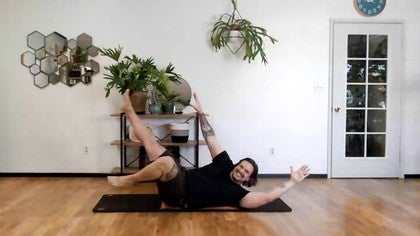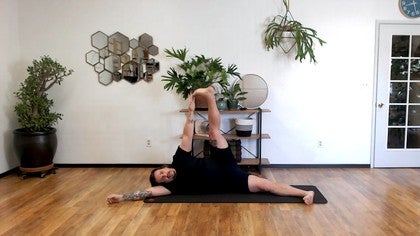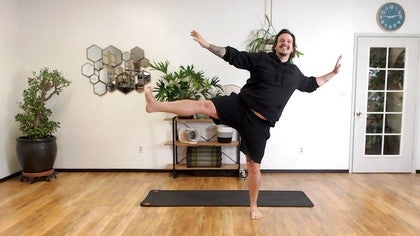Description
About This Video
Transcript
Read Full Transcript
Welcome everybody, Curious Movement. I'm James, I'll be your host. You will need something special today. A very sophisticated Prop that I have fallen in love with, it's called a Pillow. So just grab any pillow you've got.
Word of advice, if it's like a Goose Down thing, it's not going to be what you want. You want like a Chippy Pillow. And if you don't have that, just grab like a blanket or something that you can fluff up, and it's gonna give you some feedback. You'll understand why in just a moment. For now we're just gonna set it aside.
It's very sophisticated, so handle it, handle it with care. So welcome back. We are gonna start off with the Nervous System Warm-ups that we did last week. We're gonna kind of zip through some of them and then today is all about the senses. So we're gonna be playing with how we intake the world through our sensory systems and how that is applicable and guides movement.
So with no further ado, let's bring our hands together, get them nice and warmed. And we are gonna just put them on the front of our throat. Again, if you wanna know more about these nervous system warm-ups, tune in to last week's class, we covered them in depth. For now just feel the warmth, just kinda be here, nice and relaxed. Then maybe take your right hand to the left throat, dragging it towards midline, as you twist your face.
Just a nice little throat massage, nothing too precious. Here's the beautiful thing with all of my work. I have one rule in my movement classes. The one rule is, whatever you're doing, you are doing it right. Take your hands maybe tap your chest, because there is absolutely no wrong way, to move.
There's no wrong way to do any of this work. From there, take that all the way down into your hands. Maybe just a little arm slapping here just kinda waking up the body, like it's time to move, It's time to wake up. Maybe I go down into my belly, into my legs, change my seated position here. Just kind of waking everything up in the body.
Just take my hands, shake it out. (sighs) Then I'm just gonna take and kinda tap my face a little bit. Just kinda waking that up cause we're gonna use our face today. Now, if it feels really good for you, go ahead and keep doing all of that. Do whatever of that, makes you feel good.
I'm gonna take us into a breathing practice. Last week we did four, seven, eight. Mostly we got really good feedback, but I said this week I would do the Box Breathing to sort of help us get towards that four, seven, eight in a more cohesive fashion. So Box Breathing, super, super easy. Want you to imagine a, an invisible square in front of you.
I'm gonna use a count of four, so all sides, have a four count. We do an inhale, hold, exhale, hold. Inhale, hold, exhale, hold. I'll do the counting, you do the breathing. Take a nice deep inhale, big exhale.
And together we're gonna inhale to a count of four, three, two, hold your breath. Four, three, two, exhale. Four, three, two, hold your breath. Four, three, two, inhale. Four, three, two, one, hold.
Four, three, two, one, exhale. Four, three, two, one. Four, three, two, one. Four, three, two, one. Four, three, two, one.
Four, three, two, one. You do it on your own. Take an inhale, hold your breath for as long as you think you did inhale, exhale however long you think you've held your breath, then hold your breath again. It doesn't have to be precious. Four counts are just a suggestion.
You could do a three count. You could do whatever makes you feel good. It's just consciously choosing to breathe, taking a pause, taking a pause. Good. Then just calm your breath and just notice whatever you notice.
(inhales) (exhales) Good. Okay. So, have you ever wondered why you have like eyes and ears? Well, my opinion is that, they are there to guide us through life. They're there to guide us through the world.
And why are we not including senses more in our movement experiences? So today it's all about awakening our senses, in movement towards better movement. So we're gonna start with a sense of touch. So take your favorite foot. I'm gonna sit like this.
I'm gonna kind of turn this way, so you can see me. And we're gonna start off with a little foot massage. So we're gonna take and just kind of do a generic little massage there. We're not gonna get too particular about it, cause we actually have a week, all to do with feet and legs. We're gonna get more particular, but we're just going to be here for a bit.
Just generic massage, whatever works best for you. Even just kind of taking and rubbing the foot, slapping the foot, hitting the foot, twisting the foot just giving it a little bit of attention and then let's do the other side. Again, this is the quick version of a foot wake up. It's just a sort of wake up that sense of touch. Stick with me in a few weeks, we're gonna cover all of this.
Good little twists, little punches and slaps, just feeling your foot, whatever the case may be. Beautiful. From there, let's move on to the hands. Take your hands and just sort of rub them together. Get them nice and warm.
Then imagine you're going to give your own hand, like a really sturdy handshake, interlock the fingers, kind of squeeze them and release. Then go the awkward way. The way you went was probably the intuitive way. If you kinda do a little twist the other way and interlock the other way, it feels unnatural. Purposefully, little squeeze and release squeeze release, squeeze release.
Now I can just go like pinky to index finger. I can do thumb to index finger. Just sort of interlacing my fingers in really different and unique combinations each time, just to create a sense of waking up my hands, then I can just kind of rub the back of them. There's so much information that is available to us, through our hands and our feet. I'm just gonna take in finger flick, a bit.
I just imagine that I've got tons of water on my hands and I'm just, you've just washed your hands for the appropriate amount of time. And now you gotta flick off the water. It's a very Pandemic Centric Movement. We're just flicking, and then clap. Waking up our hands, and then just be there.
Shake them out and just notice, how much more aware, you are of the hands. From there, let's travel through a little bit of ear stuff. So I invite you to sit or be comfortable and just take a journey inside of yourself for a moment. I want you to embody your ears. That's the only key I'm gonna give you right now, embody your ears.
We're gonna get more specific with it. What do you notice? Often when we embody, we're looking outside of ourselves sort of at ourself, which is not embodiment, It's looking in, at ourselves. I wanna look outward. So imagine, you're in your brain for a moment, just be in your brain.
Let yourself drop down to be in between your two ears. And I want you to imagine you are inside of your right ear canal, and you are looking out of your right ear. Can you soften and be with that right ear canal enough that the little bitty hole of the ear canal gets so big, It's like a tunnel looking out towards the right side of your room. Let that soften your jaw, let it soften your right eye. And then take a look out of your left ear canal.
No need to compare, no need to judge or say that's my good one or my bad one. It's just two very unique experiences. (exhales) You're getting to know right and left side a little bit differently. Then, take your favorite hand, and do a little snap. If you can't do a snap even just like making some noise with your hand.
If you've got a little noise maker, you can do that. I'm gonna snap and I'm gonna close my eyes, turn off the sense of sight. And I'm gonna listen out of my right ear. If I don't know how to do listening out of my right ear, imagine you're inside of your body and you're looking out of your right ear. And I'm just gonna try to Echo Locate or listen to the snaps.
Listen to the fact that they're behind me, or out to the side or up above me or out in front of me. They can come close or far. Now you can do that for as long as you'd like to do it. For the sake of the class, I'm gonna jump on over here and I'm gonna do it over here. And immediately I notice, the sound is different over here, and that's okay.
Just waking up my left hearing experience. Now, if I find that one side needs a little more love or TLC maybe I stick with that side. For me, I'm gonna go to both and I'm gonna see if I can listen out of both ears and maybe one goes forward or back. Then I'm just gonna be for a moment. And I'm gonna listen.
This is so unsexy to watch. I'm just gonna listen to the sounds of the room. Here I notice that there's traffic out front. I can notice sort of the subtle buzz of lights in the room. I'm gonna begin to notice my own breath.
Can I listen to the sound of inhalations and exhalations? Not judging, just simply allowing that to come into the system. Now again, you can be here for as long as you want to be here. I'm gonna move on, to my eyes. So, we're gonna start with one of my favorite exercises that is also taught in trauma and stress relief scenarios.
We're using it as a waking up, but, know that this is also really good for your nervous system. It's so simple. Start to look around your room, and just notice whatever you notice. This is Objective Viewing. I want you to start naming the things in your room.
Here It would be plant, bicycle, Cadillac, plants, basket, chair window, door, light, light, reformer, box, more plants. And you're just sort of intaking, without giving it a subjective view. You don't go ugly plant or that thing that I need to change, or that thing I really love. You're just naming things. You're just intaking your world.
It's called orientation. And I'm just orienting myself within my room getting to see and sense and intake my environment. Now, if that feels like a lot for you because maybe that's the first time you've ever just stopped and looked at your space, keep doing that. I'm gonna up-level it, just a bit. I'm gonna choose to keep all my bones, still.
And I'm gonna make just my eyes, look around the room. Now with this, doing the same exact process, I'm just using my eye muscles to do that now. And I notice that I can't see as much, obviously, cause I'm not twisting, but I'm really trying to see what's over there. And I'm really trying to see what's down there and what's over there. And I'm trying to do it in a way that avoids blink switching.
I'm trying to take a panoramic sweeping view of the room instead of there and there and there and there. So just give your time, give yourself time to pan and intake, the room. Now, let your eyes look forward. Let your nose look forward. Make your eyes, look to the left and then make your eyes look to the right.
Again, We're looking for that sweeping Pan Shot versus a blink switch. I'm not looking right forward then left, or staccato. You'll notice that a lot, where it's like, there, there, there, there, there. Can the feeling be more panoramic. Like I'm just relaxing my eyes to do that.
From there, maybe as my eyes look to the left, my nose looks to the right and then they meet in the middle. And as my eyes look to the right, my nose looks to the left and vice versa. Good. From there, eyes look up and then down, and up and down, up. And maybe as my eyes look up, my nose looks down and vice versa.
If you notice any nervous system chaos, coming up like you just feel like, Ooh, I don't like that. Or it brings up a disagreeable feeling. Well you've got tools. (exhales) Neck, whatever it is, shaking it out. Finger flicks, just continuing to move.
From there, I'm gonna make my eyes look forward. Pick something to look at. I'm gonna keep looking at that and begin to draw a circle with my nose. And I can make it as big of a circle or as little of a circle. But I'm considering the shape of a circle.
And I'm being very intentional with drawing, sad circle. This is one of those moments. And then reverse. This is one of those moments where on replay, I'm gonna watch it back and go, James you were not doing a circle, (laughs) and that's okay too. Good. And then relax.
Bring both hands together. You are going to keep your eyes on your index finger no matter where your index fingers go. So you're gonna reach out in front of you. You're going to bring them towards your nose. It's a cross-eyed moment.
Then you're going to move them away from you. You're going to open them up, and now you are looking into the periphery. How far back can you go, keeping those index fingers in the peripheral vision? And then, bringing it back in, all the way in. All the way back out, all the way back out.
one more of those. These are good homework pieces for you to play with on your own. I just wanted to introduce some ideas here today. Good. Now, just be still for a moment.
And just, how are you intaking your room differently? How is your experience shifted? For me, I wanna share my experience. I feel more settled and I'm really noticing peripheral vision. Now, like I'm noticing what's in the room.
Like, Oh, there's a chair over there, and there's a ladder over there. Instead of just focusing on the camera in front of me. How is yours changed? Then let your head drop, let your head rock over and let your eyes look for something in the room. Let your head drop and over.
And your eyes look for something in the room. Head drops, eyes look. Maybe there's an inhale, a moment of I'm alive. (inhales and exhales) One more. Beautiful. Okay.
Pillow time. Grab your pillow, put it down. If you have like a Throw Pillow, you might want two of them, because as you put it down and you may also, if you have a sensitive neck, you may want something for your head to rest on. Maybe a shorter pillow or a smaller pillow or a rolled up towel of some sort. But we're gonna go here.
And this pillow is going to be the length of my spine. I want it to be a little more, here. So for me it ends, right at sort of shoulder height. And I'm just here. And I'm just gonna create a relationship with the pillow by sensing where the pillow is.
And I'm gonna take a breath as if my breath can depress or squish the pillow. And exhale. Now, right now, you're just gonna keep breathing as I talk, sensing the pillow. I in my own body and in my client's body have noticed everyone has back issues right now, spine issues cause we're holding so much stress there. And so much of the spinal work we are taught, are big gross movements, meaning they're just they're big movements and that's great.
But I want us to acknowledge what the spine actually is. It's very intelligent cells. You've got your spinal cord surrounded by multitudes of joints, filled with proprioception. You do not need big movements to wake up the spine. You need, soft, supple supportive, small, intelligent-wise movements.
That's our thinking process. Taking in, our inhale. Now, I'd like for you to sort of yaw or squish the left side of the pillow, just a little bit. And then yaw or squish the pillow to the right, just a little bit. You're just taking, it's micro movements.
I don't need to be way over here to do that. It's like how little movement can I effort in order to feel moved? Just kind of rocking. Maybe I even breathe into that, and I'm just rocking right and left, letting the backside of my body wake up. Senses are not just eyes and ears and taste.
Sensation is also touch. Being touched by the pillow. I'm just rocking. Now, if that feels good, if it was me, I would just continue. I'd probably do this for the rest of the class to be honest.
But we're gonna now, take our feet up and we're just going to rock. Sensing the pillow, waking up that backside of the body. You don't have to effort to wake something up. You just have to be naturally aware and go, Oh look at that, I feel something back there. Then I can set my feet down.
I can lift my head. And if you need a head support, you can do that. And I can just rock up here. Just kinda waking up shoulders. Then I can just do this whole thing.
Last week, we talked about liberating our limbs. So I can just even begin to liberate the limbs. And just, where do I wanna go? Knowing that I'm supported and feeling something behind me. This leg and our movement is not the experience, the experience is happening behind me.
These are all just choices. And then I can rest, And be there. Now, coming up, turning over. let's take and put this sort of on the front of the spine. Now, from there, I'm gonna choose to be on my forearms and I'm just gonna breathe into the pillow, squishing with my breath, exhaling, allowing to be available to the sensation.
If I wanted to, I could come down and rest my forehead. I'm just gonna be here. Then I can rock kind of did a little bit of this last week. I'm just feeling or waking up sensation on the front of my body. Nice deep inhale.
Nice deep exhale I'm just, you can't get this wrong. There is nothing to get wrong or right here, these are just really feel good experiences. Just rocking and moving. Good. Then, I'm gonna come up.
I'm going to adjust my pillow and I'm gonna put my hands on it. Now we've all seen cats knead, right? Or we made bread of some sort. So you're going to just imagine that you are either a cat Kneading this or you're making bread. We're just letting our hands touch and manipulate a really interesting surface.
They like that. We don't do this sort of stuff, enough. So we're just waking up possibility, through movement. Then, this is my favorite. This is an exercise and movement experience, I give to my clients all the time.
If you need something to hold on to, hold on to it. But we're gonna take and step on the pillow. And again, my feet are going to knead the pillow. We talked about this in the last experience, of like looking at your foot and imagining it's the hand at the end of your leg. So I want you to just look down and go, what other interesting things can my feet experience here?
Maybe they wanna be half on a pillow and half off. Maybe they wanna go externally rotated or tiptoed or lifting or squeezing with my toes. I'm not gonna guide, I'm not gonna tell you, how to live your experience here. I'm gonna say, there's a pillow, you have feet, move the pillow with your feet. Good.
Now, we can take this pillow and sort of set it aside for a moment. left leg in front, right leg to the side to the best of your ability today. Because my right leg is to the side, my right arm is going to be up. My right hand is now transformed into a Paper Airplane. Paper Airplanes have one rule.
The one rule is they always fly nose first. So I will always have my paper airplane fly, fingernail first. It can never go backwards, it can never levitate, it can never move to the side. Cause paper airplanes don't move like that. So wherever my paper airplane goes, I have to follow it with my eyes, and I have to be conscious and have some integrity around that movement that I don't just go, well, it's just easier to take it backwards.
I've always gotta fly, nose first and keep my eyes on it. Now it can be small, Or as I go through that, maybe I wanna get adventurous. And I want it to go forward. Maybe I want it to go backwards. Maybe it takes me up.
Maybe it moves me way around. Where does your paper airplane, want to go? Then think of all of the body parts you're moving right now. Things that you may not move otherwise, in combinations that might be novel or new for you. Then switch legs, switch paper airplanes.
It's a way of taking all of that sensation stuff, we practiced or woke up and integrating it. We're just sort of playing here. I can take and have two paper airplanes. Now, here we go. Paper airplanes always have to fly nose first, but they can deviate and I can use my peripheral vision, or keep my eyes on it and focus.
My paper airplanes can fly together. They can move sort of around one another, but there's integrity there. I'm making choices and being conscious of it, and having some movement fun with it. Then come back into your body. Be inside of your body for a moment.
Take a nice deep inhale. Just notice whatever you notice. Now let's take all of those skill sets, onto the mat for a, not that we haven't been moving, but a little more structured movement practice. I don't want you to do the exercises, I want you to become the movement within the exercise. Let me explain.
Come down, knees bent, hands down. Come up into your bridge, and back down. One more, just doing it. Up. And down.
Now, feel the floor with your hands. Feel the floor with your feet. Notice what else is touching the floor. Maybe even the back of the head. Start to push the floor away from you without lifting, Then let it lift you up.
Maybe even sensing the back of the head, begin to look for the wall behind you and come up a little higher and then rest, relax. Let your eyes change gaze, let your body soften into the floor and a yield. One more, I'm pushing but I'm very aware of what I'm touching. I come up, where am I looking? I'm going that way.
I wanna look that way. And then, one more. I go up, And, I come back down. Let's add some vocalization and some sounding into that. Take a nice deep inhale.
Let yourself sigh, yawn, express yourself into that. (sighs) Maybe there's a hum. (humming) Maybe there's a yawn. (yawns) Let yourself be heard. Let yourself be felt from the inside.
One more of those. (sighs) All the way down. Pick your favorite leg, lift it up towards the ceiling. Take a look at that foot. That foot is now going to make a circle.
This other leg, wherever you want it. I'm gonna straighten mine out. I want that foot to make the biggest circle it can make. And I'm gonna let my eyes follow it. Maybe it even takes me this way.
Maybe I've gotta look for it. It goes up wherever it wants to go up. It goes over and I'm literally tracking it with my eyes, as it goes, paying attention to the back side of my body. How am I being supported by the floor here? Then reverse.
(sighs) One more. Pick your other leg up. Look at it. Let it start to move wherever it wants to go. But, you are gonna keep your eyes on it.
And then it can reverse. It can be big, things can move. It's about expressing bigness in that movement, and then lay it all the way down. Now, you know, you have feet down there. I want you to pick your head up and look for your feet.
Wiggle your toes and then back down, pick your head up, look and back down. From there, I want your eyes to do the work of lifting your head. So my eyes start to really look, really look and really look. And it's like, it only needs to lift that high. And then back down.
How little bone movements can you do, to lift, making your eyes do the work? As I do that my experience is like a deeper core connection, all the way up to the throat. Yours might be different. Good. Pick one leg up, maybe five inches off the floor. Take a look for your feet, and back down.
Switch legs. Take a look, back down. If you'd like, both feet, not super high, take a look for it. Wiggle and down. Both feet, take a look and back down.
Maybe your practice today is feet down, taking a look. One more of whatever works best for you. Rest. Breathe into the floor. That was stressful for the body, there was some exertion there. Maybe you need to do some tapping.
Maybe you need to do some wiggling. When you're ready, join me on hands and knees. So, I want you to just do some Cat-Cows to begin with. However it is, you know, to do cat-cows. So I do an extension and I do a flection.
Then end in your cat, stay in your cat, make your eyes look for your own eyebrows. Make your eyes look for the front of your mat. Make your eyes look for the wall in front of you. Make your eyes look up at the ceiling. How high on the ceiling can you look?
Hold. Only shift your eyes. Make your eyes look for your nose. Look for the mat. Look for your hands.
Look for your knees. Look for your own belly button. Hold. Make your eyes look for your eyebrows. And my eyes are looking, looking, looking, looking, looking.
Maybe I even hold and take a great big inhale. Smell my room. Exhale, eyes divert, exhale. Maybe there's a yawn. (yawns) My eyes look, I take a great big inhale, maybe I even listen to the room and I sort of allow myself to get drawn into the room.
Wide, big, take an inhale, exhale. Maybe there's a sigh. (sighs) One more. (sighs) Beautiful. Lying on your stomach.
We're going to go into a version of double leg kick, but we're gonna enter into it a little bit differently. So, I'd like for you to take both hands behind your back, have one hand grab a hold of the other and work them up towards your ribs and then relax your elbows down. You can rest your head, I got a Mic on, so I'm not gonna rest my head. I'm gonna just be here. My hands are now going to caress my low back, all the way, say crumb, tailbone, pulling, pulling, pulling.
I can feel this inviting my upper body up, So I'm gonna divert my eyes up. Let it lift me, take a nice deep inhale. Exhale, come back through it. Feel your hands touch, your spine, guiding you down. If it feels good for you to binge your knees here and do a little stretch, do it.
You don't have to. Then be touched by your hands. Feel the support underneath you as if you have a pillow underneath you. Maybe you want to roll to the right or the left. Maybe you just wanna be in center today.
Here's what I'm curious about. How does it change, If you look somewhere else? I start to touch, I feel invited up and I look to the left. I'm going to touch, I'm gonna choose to look to the right, then I'm invited up with a twist. (sighs) One more.
whatever you wanna do with it. All the way down. Just take and wiggle. From there, we're going to do what I call Favorite Exercise because it's literally no one's favorite exercise. And it will be repeated throughout the remaining weeks.
So you might as well get used to it now. Tuck your toes, take your hands underneath your armpits, bring your elbows together. For you at home, let your nose, touch the floor and relax into it. Again, you will not see me touching the floor with my nose. Just assume that, that's what's happening.
From there, I'd like for you to imagine that the floor, all of a sudden smells and you've got to retract or pull your face away and then relax. Pull the nose away from the floor and back. Your eyes should still be looking toward the floor, and back down. One more. Back down.
Now, keep your nose on the floor. Keep yourself relaxed and see if you can pull all of your ribs, away from the floor and back down. You'll notice you have to push with your hands a bit, and relax. Again, noses on the floor, knees are on the floor, ribs are not and relax. So we have a nose thing and we have a ribs thing.
From there, lift your knees, keep your ribs and your nose down. Lift your hips off the floor and back down. Knees and hips belong together, so that's my pelvis lifting, and down. And lift, and down. One more.
Lift and down, nose away from the floor and down. Ribs away from the floor and down. Pelvis away from the floor and down. Pelvis away from the floor, nose also away from the floor. Back down.
Ribs away and down. Nose and ribs away. Pelvis is down, all the way down. Pelvis up, ribs up, nose up, low pushup and down. Nose, pelvis, hips, hold.
Hold, hold, hold, and relax. Wiggle it out. Wiggle it out. You can sit up now and maybe you need a little calming work. Maybe nearly a little breathing, maybe a little orientation.
Like where, where am I? After whatever that just was. Beautiful. From there, we're going to come into hands and knees position. We're gonna lift the feet off the floor.
From there, I'm going to look as far, actually let's do this. I'm gonna look down between my two hands and I'm imagining I'm a little kitty cat and I'm gonna come down and drink some water and back up. coming down and back up. Now maybe that's where you like to be. For me, I'm going to imagine that bowl of water gets moved forward on the mat.
So I'm looking at it and I wanna come down and back up. Come down and back up. How far in front of you, can you move that bowl of water? Can you go forward and come back. Forward and come back.
Forward and come back. And notice that there's a play here. Back to rebound and feeling myself through my environment. And I'm choosing where I'm gonna go through my senses. Then I can come all the way up, and be here for a moment and acknowledge that there's a mat.
Take a look at the space. Relax. Disengage my head, make my eyes look for my feet. Allow gravity to take me down. Look where I wanna go, walking out, being here.
Pulling my nose away from the floor, ribs and pelvis away from the floor coming down. Do I wanna go forward? Do I wanna come straight down? Part of the way down? Where do I wanna go?
Come back up. Rebound backwards. Walk slowly, restacking up. Be here. I've got feet, there's a room.
Again, coming down, where do I wanna walk to? pull my nose away from the floor. Ribs, pelvis, Keep it away from the floor. Decide where you wanna move to, back up and rebound back. Restack.
Settle in. One more of those things. Long and down, up, walk back. Just be there for a moment. Take a walk on your mat.
Let your feet feel whatever it is that's underneath your feet there. Come to your center there, lift all of your toes. Spread your toes, set them down, lift them, spread, set them down. Lift, spread, set them down. Lift, spread, such as the big toes down.
And then the four. Big toes, four, big toes, four, big toes, four. set all your toes down. Pick up your heels, drop them, pick up your heels, drop them. Start to take a look around your space, orient to the space and maybe pick up the speed, so that there's like a hopping thing, that is going on here. Let yourself be moved.
Maybe I'm just playing, feeling my feet against the ground. And just relax. Paper airplane. Where does the paper airplane wanna take you now? That we're gonna make a rule.
Both feet stay down. Where does that paper airplane, want to go now? And then maybe the other one comes in. How about if you have to keep one foot off the ground? Woo, little dynamic balance.
Other foot. Feel free to take a walk with it. Just playing. Give yourself permission to be human and express for maybe just a moment. Maybe an inhale and moving through it.
Maybe we come down and back up, so many options. Then just be with yourself. Take a look around your room. Nice, deep inhale. Nice deep exhale.
And I want us to have a moment that acknowledges the human experience of whatever it is you just went through and whatever you feel right now. So take a nice deep inhale, on your exhale, make a noise. (sighs) You have a pillow. If your noise wants to be a scream or a loud noise, do it under the pillow. You can just, (sighs) we're gonna see if we can work our way up to a laugh.
Now, if you don't know, I have an infamous slash famous laugh. So I'm gonna start laughing, and hopefully I bring you along for the ride. Laughing creates the hormones, the feelings of joy and excitement. And that's how I want us to end today. So, (inhales) (laughs) (sighs) Letting ourselves feel and sense, and acknowledge that we're humans.
And we have a human experience with choice and freedom, and things that we intake in life and it's inside of us and it's inside of you. And I want you to feel that and know that, so that you, can trust your experience. Let's end the class the way I always do. Hands on your heart, Take a nice deep inhale into your own heart. Tell yourself thank you for being here today.
Take a look around your room. You literally could not have done today's practice without your space. It was an active participant, in shaping you for the day. So tell your space. Thank you.
Thank you space. Thank you world. Take a look at your community. Anyone that is there with you, dogs, cats, plants, human beings included, anyone here on screen. Anyone you meet the rest of the day, tell your community, Thank you so much.
I thank you guys. You are the community that makes this happen. Thank you. So, so, so much. Again, I'm James Crader.
This is Curious Movement, and I hope you join us again next week for another exciting installment. Thank you so much.
Mindful Movement: Curious Movement
Comments
You need to be a subscriber to post a comment.
Please Log In or Create an Account to start your free trial.























